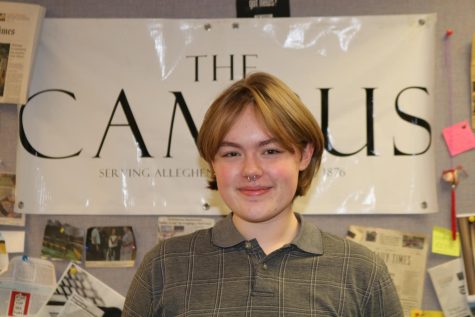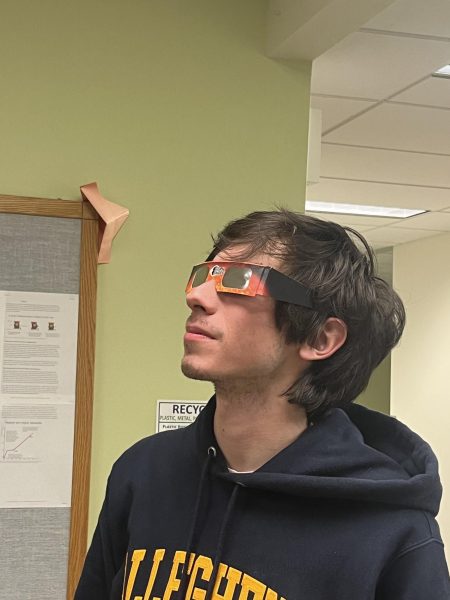The Oddfellows chimney swift dilemma
If you pass by Oddfellows Hall on a summer day, you are likely to hear a distinct chatter from above. Look up, and you may catch a glimpse of a small, gray figure swooping through the sky. Those sights and sounds come from chimney swifts, birds that — fitting to their name — reside primarily in chimneys.
But you may not hear that distinct chatter coming from Oddfellows for long. According to the Allegheny Master Plan published in May 2019, Oddfellows will not be sticking around forever. The removal of Oddfellows, and therefore its chimney, would mean the displacement of the chimney swift population on Allegheny’s campus.
The Master Plan was developed to “chart a course for Allegheny College’s physical development and commitment to sustainability over the next two decades,” according to its summary.
The summary lists the removal of Oddfellows as a “Phase 2” project, designed to take place five to seven years after the implementation of the plan. It also cites the goal of the project as one that will reduce square footage, thus reducing the college’s annual cost of ownership.
Whether or not the building will be leveled in the next several years is open-ended, given the disruption caused by the COVID-19 pandemic. But the removal of the chimney does not have to mean the removal of chimney swifts from campus; there are solutions.
Associate Professor of English John MacNeill Miller, who works in Oddfellows and is a Pennsylvania Master Naturalist, said that chimney swifts have already been declining in population in the past several decades.
“In the last 50 to 80 years, changes in chimney architecture and changes in the use of industrial chemicals for pesticides and insecticides — combined with climate change — have all been affecting their populations negatively,” Miller said.
Though the species is not classified as endangered, its decline in population is still something to look out for, and something that is strictly protected under U.S. law.
“Back in the early 20th century, the Migratory Bird Treaty Act of 1918 was passed to protect basically all migratory birds in Canada, the U.S. and Central America,” Miller said, “That treaty made it illegal to knowingly kill or disturb the nest of any native migratory bird, and that includes swifts.”
So not only would the removal of the chimney be disruptive to the birds, but it would also have serious consequences for Allegheny.
“If swifts are present and nesting or roosting in the chimney of Oddfellows during the time of demolition, that’s technically illegal,” Miller said.
The solution, should the demolition move forward, would be to give the chimney swifts a new home, in the form of a makeshift chimney. This potential relocation is something that Bird Club’s president Joshua Heiser, ’23, is prepared to make happen sooner rather than later.
“Losing the roost is something of conservation concern,” Heiser said, “so we as bird club are working to install a chimney swift tower.”
As a Pennsylvania Audubon on Campus Chapter, Bird Club has made it their mission to create a new habitat for the birds, as well as raise awareness about the birds and collect data throughout the relocation process. Each Audubon Chapter serves as “a student-run club working towards the Audubon Mission of protecting birds and the places they need,” according to the Audubon website. In this circumstance, the organization has provided guidance to Allegheny’s Bird Club in terms of where to best place the new habitat.
“The main requirement for that site is that it has to be the tallest structure within a 25-feet radius,” Heiser said.
The structure has to be tall enough so that the chimney swifts can circle down into the structure without obstruction from nearby trees or buildings. In terms of implementing the chimney tower, Heiser explained that there are just a few more steps until a new home for the birds is on campus.
“We’ve already talked with (Director of Sustainability Kelly Boulton, ’02) and Physical Plant, and they’re both on board with the idea, so we’ll hopefully have that installed potentially this semester,” Heiser said.
There are options when it comes to where the chimney tower would be placed. Some potential locations include the Oddfellows parking lot, as the birds would be familiar with the location. Another option is to place the chimney tower on top of a building, to further ensure the safety of the birds as they descend into the structure.
“The hope is that the swifts are going to be using (the Oddfellows) chimney, but if there’s a roost nearby, maybe they’ll be able to see the alternative chimney faster,” Heiser said.
Both Miller and Heiser believe that the chimney tower could be an accessible place for students to study the bird population, either through lookouts or via cameras.
“I think it would provide potential study opportunities for students in biology and environmental science,” Miller said. “It would be an interesting opportunity for students and for the campus to get to know the local bird population better.”

Sam Heilmann is a sophomore from Johnstown, PA. She is majoring in Communications. This is her second year on the Campus staff, and her first as Opinion...






